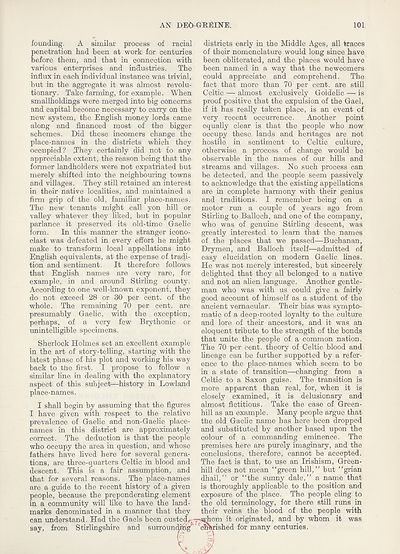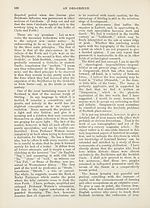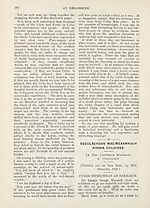An Comunn Gàidhealach Publications > Deo-gréine > Volume 17, October 1921 to September 1922
(109) Page 101
Download files
Complete book:
Individual page:
Thumbnail gallery: Grid view | List view

AN DEO-GMNE.
101
founding. A similar process of racial
penetration had been at work for centuries
before them, and that in connection with
various enterprises and industries. The
influx in each individual instance was trivial,
but in the aggregate it was almost revolu¬
tionary. Take farming, for example. When
smallholdings were merged into big concerns
and capital become necessary to carry on the
new system, the English money lords came
along and financed most of the bigger
schemes. Did these incomers change the
place-names in the districts which they
occupied? They certainly did not to any
appreciable extent, the reason being that the
former landholders were not expatriated but
merely shifted into the neighbouring towns
and villages. They still retained an interest
in their native localities, and maintained a
firm grip of the old, familiar place-names.
The new tenants might call yon hill or
valley whatever they liked, but in popular
parlance it preserved its old-time Gaelic
form. In this manner the stranger icono¬
clast was defeated in every effort he might
make to transform local appellations into
English equivalents, at the expense of tradi¬
tion and sentiment. It therefore follows
that English names are very rare, for
example, in and around Stirling county.
According to one well-known exponenf, they
do not exceed 28 or 30 per cent, of the
whole. The remaining 70 per cent, are
presumably Gaelic, with the exception,
perhaps, of a very few Brythonic or
unintelligible specimens.
Sherlock Holmes set an excellent example
in the art of story-telling, starting with the
latest phase of his plot and working his way
back to the first. I propose to follow a
similar line in dealing with the explanatory
aspect of this subject—history in Lowland
place-names.
I shall begin by assuming that the figures
I have given with respect to the relative
prevalence of Gaelic and non-Gaelic place-
names in this district are approximately
correct. The deduction is that the people
who occupy the area in question, and whose
fathers have lived here for several genera¬
tions, are three-quarters Celtic in blood and
descent. This is a fair assumption, and
that for several reasons. The place-names
are a guide to the recent history of a given
people, because the preponderating element
in a community will like to have the land¬
marks denominated in a manner that they
can understand. Had the Gaels been ousted^
say, from Stirlingshire and surrounding
districts early in the Middle Ages, all traces
of their nomenclature would long since have
been obliterated, and the places would have
been named in a way that the newcomers
could appreciate and comprehend. The
fact that more than 70 per cent, are still
Celtic — almost exclusively Goidelic — is
proof positive that the expulsion of the Gael,
if it has really taken place, is an event of
very recent occurrence. Another point
equally clear is that the people who now
occupy these lands and heritages are not
hostile in sentiment to Celtic culture,
otherwise a process of change would be
observable in the names of our hills and
streams and villages. No such process can
be detected, and the people seem passively
to acknowledge that the existing appellations
are in complete harmony with their genius
and traditions. I remember being on a
motor run a couple of years ago from
Stirling to Balloch, and one of the company,
who was of genuine Stirling descent, was
greatly interested to learn that the names
of the places that we passed—Buchanan,
Drymen, and Balloch itself—admitted of
easy elucidation on modern Gaelic lines.
He was not merely interested, but sincerely
delighted that they all belonged to a native
and not an alien language. Another gentle¬
man who was with us could give a fairly
good account of himself as a student of the
ancient vernacular. Their bias was sympto¬
matic of a deep-rooted loyalty to the culture
and lore of their ancestors, and it was an
eloquent tribute to the strength of the bonds
that unite the people of a common nation.
The 70 per cent, theory of Celtic blood and
lineage can be further supported by a refer¬
ence to the place-names which seem to be
in a state of transition—changing from a
Celtic to a Saxon guise. The transition is
more apparent than real, for, when it is
closely examined, it is delusionary and
almost fictitious. Take the case of Green-
hill as an example. Many people argue that
the old Gaelic name has here been dropped
and substituted by another based upon the
colour of a commanding eminence. The
premises here are purely imaginary, and the
conclusions, therefore, cannot be accepted.
The fact is that, to use an Irishism, Green-
hill does not mean “green hill,” but “grian
dhail,” or “the sunny dale,” a name that
is thoroughly applicable to the position and
exposure of the place. The people cling to
the old terminology, for there still runs in
their veins the blood of the people with
-~44(hom it originated, and by whom it was
‘ 'enfcrished for many centuries.
101
founding. A similar process of racial
penetration had been at work for centuries
before them, and that in connection with
various enterprises and industries. The
influx in each individual instance was trivial,
but in the aggregate it was almost revolu¬
tionary. Take farming, for example. When
smallholdings were merged into big concerns
and capital become necessary to carry on the
new system, the English money lords came
along and financed most of the bigger
schemes. Did these incomers change the
place-names in the districts which they
occupied? They certainly did not to any
appreciable extent, the reason being that the
former landholders were not expatriated but
merely shifted into the neighbouring towns
and villages. They still retained an interest
in their native localities, and maintained a
firm grip of the old, familiar place-names.
The new tenants might call yon hill or
valley whatever they liked, but in popular
parlance it preserved its old-time Gaelic
form. In this manner the stranger icono¬
clast was defeated in every effort he might
make to transform local appellations into
English equivalents, at the expense of tradi¬
tion and sentiment. It therefore follows
that English names are very rare, for
example, in and around Stirling county.
According to one well-known exponenf, they
do not exceed 28 or 30 per cent, of the
whole. The remaining 70 per cent, are
presumably Gaelic, with the exception,
perhaps, of a very few Brythonic or
unintelligible specimens.
Sherlock Holmes set an excellent example
in the art of story-telling, starting with the
latest phase of his plot and working his way
back to the first. I propose to follow a
similar line in dealing with the explanatory
aspect of this subject—history in Lowland
place-names.
I shall begin by assuming that the figures
I have given with respect to the relative
prevalence of Gaelic and non-Gaelic place-
names in this district are approximately
correct. The deduction is that the people
who occupy the area in question, and whose
fathers have lived here for several genera¬
tions, are three-quarters Celtic in blood and
descent. This is a fair assumption, and
that for several reasons. The place-names
are a guide to the recent history of a given
people, because the preponderating element
in a community will like to have the land¬
marks denominated in a manner that they
can understand. Had the Gaels been ousted^
say, from Stirlingshire and surrounding
districts early in the Middle Ages, all traces
of their nomenclature would long since have
been obliterated, and the places would have
been named in a way that the newcomers
could appreciate and comprehend. The
fact that more than 70 per cent, are still
Celtic — almost exclusively Goidelic — is
proof positive that the expulsion of the Gael,
if it has really taken place, is an event of
very recent occurrence. Another point
equally clear is that the people who now
occupy these lands and heritages are not
hostile in sentiment to Celtic culture,
otherwise a process of change would be
observable in the names of our hills and
streams and villages. No such process can
be detected, and the people seem passively
to acknowledge that the existing appellations
are in complete harmony with their genius
and traditions. I remember being on a
motor run a couple of years ago from
Stirling to Balloch, and one of the company,
who was of genuine Stirling descent, was
greatly interested to learn that the names
of the places that we passed—Buchanan,
Drymen, and Balloch itself—admitted of
easy elucidation on modern Gaelic lines.
He was not merely interested, but sincerely
delighted that they all belonged to a native
and not an alien language. Another gentle¬
man who was with us could give a fairly
good account of himself as a student of the
ancient vernacular. Their bias was sympto¬
matic of a deep-rooted loyalty to the culture
and lore of their ancestors, and it was an
eloquent tribute to the strength of the bonds
that unite the people of a common nation.
The 70 per cent, theory of Celtic blood and
lineage can be further supported by a refer¬
ence to the place-names which seem to be
in a state of transition—changing from a
Celtic to a Saxon guise. The transition is
more apparent than real, for, when it is
closely examined, it is delusionary and
almost fictitious. Take the case of Green-
hill as an example. Many people argue that
the old Gaelic name has here been dropped
and substituted by another based upon the
colour of a commanding eminence. The
premises here are purely imaginary, and the
conclusions, therefore, cannot be accepted.
The fact is that, to use an Irishism, Green-
hill does not mean “green hill,” but “grian
dhail,” or “the sunny dale,” a name that
is thoroughly applicable to the position and
exposure of the place. The people cling to
the old terminology, for there still runs in
their veins the blood of the people with
-~44(hom it originated, and by whom it was
‘ 'enfcrished for many centuries.
Set display mode to:
![]() Universal Viewer |
Universal Viewer | ![]() Mirador |
Large image | Transcription
Mirador |
Large image | Transcription
| An Comunn Gàidhealach > An Comunn Gàidhealach Publications > Deo-gréine > Volume 17, October 1921 to September 1922 > (109) Page 101 |
|---|
| Permanent URL | https://digital.nls.uk/127171281 |
|---|
| Description | Leabhar 17, Treasamh Mios an Fhoghair 1921 gu Dara Mìos an Fhoghair 1922 |
|---|---|
| Attribution and copyright: |
|
| Description | This contains items published by An Comunn, which are not specifically Mòd-related. It includes journals, annual reports and corporate documents, policy statements, educational resources and published plays and literature. It is arranged alphabetically by title. |
|---|
| Description | A collection of over 400 items published by An Comunn Gàidhealach, the organisation which promotes Gaelic language and culture and organises the Royal National Mòd. Dating from 1891 up to the present day, the collection includes journals and newspapers, annual reports, educational materials, national Mòd programmes, published Mòd literature and music. |
|---|---|
| Additional NLS resources: |
|

